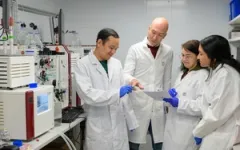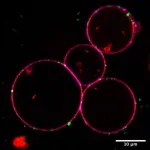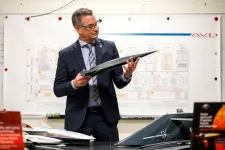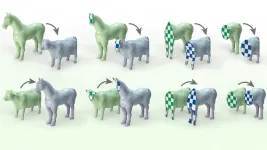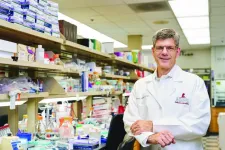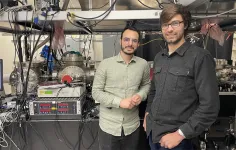(Press-News.org) A University of Texas at Arlington civil engineering researcher will use a NASA grant to help forecasters better predict extreme weather events using a variety of existing NASA data sources.
Yu Zhang, associate professor in the Department of Civil Engineering, said the $638,000 grant will use ocean circulation data, atmospheric conditions and current weather information to make longer-range forecasting more reliable. Having a more accurate forecast could help officials make better decisions about the state’s water resources—for example, knowing when to release water from reservoirs.
“Using NASA data, we want to increase the accuracy of forecasts for extreme wet and dry conditions,” Zhang said. “It takes two to three weeks for water released from reservoirs to travel from North Texas to the coast. Reservoir operators have to take that into account when releasing water up here because it has an impact south of us. We will determine if the data we have available can help us predict those events. We have to have a better forecast lead time.”
The project is titled “Improving Subseasonal to Seasonal (S2S) Hydrometeorological Predictions for the State of Texas Through Synergistic Infusion of Remotely Sensed SST (Simulation and Software Technology) and Land Surface Variables to a Coupled Modeling System.”
S2S refers to a range of forecast lead times associated with weather and climate forecasts. Currently, there is a gap in the capabilities of operational forecast systems that limits the accuracy of forecasts at the S2S range. A consortium of federal agencies, including the National Oceanic and Atmospheric Administration, has empowered NASA to place a high priority on improving S2S forecasts to address existing and emerging needs in various economic sectors, including water supply.
Typical weather forecasting spans 14-15 days, while climate forecasting generally is for the next three to six months under average conditions. Existing NASA data could help improve S2S forecasts.
“NASA wants to see how the data collected through existing missions can be used to improve forecasts to guide their future missions,” Zhang said.
He believes the new information his project produces could help determine the potential impacts of land surface temperature and soil moisture in the spring on the emergence and intensity of summertime droughts.
“Over the last 10 years, we’ve had more extreme weather events, and so we should be able to harness all that data to understand the contributions from land and ocean to the occurrence of these events,” Zhang said.
Melanie Sattler, interim chair and professor in the Department of Civil Engineering, said Zhang’s work is needed in Texas because the state’s weather is so varied.
“Finding out how NASA data can be used to improve forecasts will inform the development of future weather models whose forecasts will contribute to saving lives and property,” she said.
END
NASA data could lead to more accurate weather forecasts
UTA project uses existing NASA data to make better predictions about extreme weather
2023-05-24
ELSE PRESS RELEASES FROM THIS DATE:
Digital engineering to reduce risks that lead to brain injuries
2023-05-24
A University of Texas at Arlington engineering researcher who studies traumatic brain injuries has received funding to use computer motion simulation that replicates the movements of a person performing activities that could lead to injury.
The project, funded by a nearly $1 million grant from the Office of Naval Research Defense University Research Instrumentation Program (DURIP), will use real-time data of phantom head and phantom body reactions to ascertain what physical injuries could come from those motions.
Ashfaq Adnan, a UT Arlington professor in the Department of Mechanical and Aerospace Engineering, is leading the project, called “System for Remote ...
A look into the heart of cellular waste disposal
2023-05-24
To prevent our body’s cells from overflowing with garbage and to keep them healthy, the waste inside them is constantly being disposed of. This cleaning process is called autophagy. Scientists have now, for the first time, rebuilt the complex nanomachine in the laboratory that starts this process – and it works quite differently from other cellular machines. The researchers’ new insights could help open up new approaches for the treatment of cancer, immune disorders, and neurodegenerative diseases in ...
Designing a next generation hypersonic demonstrator
2023-05-24
Today, large commercial jets fly around 580 mph. The Lockheed SR-71 Blackbird introduced in 1966 is the fastest supersonic jet vehicle in the world, reaching speeds of more than 2,200 mph, nearly four times faster than a commercial jet.
The fastest rocket-powered hypersonic vehicle developed in the late 1960s carrying a human has been the North American X-15, reaching a top speed of 4,520 mph, twice that of the SR-71.
Recently, the U.S. Air Force has awarded a contract to engineer Project Mayhem with the goal to reach 4,603 mph. Now, imagine a vehicle that could fly much faster, maybe even above 6,905 mph, which is beyond nine times the speed of sound.
The University of Texas at Arlington’s ...
Confusion over VAERS: Why the vaccine safety reporting system should be renamed
2023-05-24
PHILADELPHIA – The federal health system for reporting “adverse events” after vaccination, known as VAERS, is designed to assist in the early detection of complications and responsive action. But when the pandemic and advent of new vaccines for Covid-19 turned a spotlight on this formerly little-known system, the flood of web and social media references to it was accompanied by confusion about what the system is and what the reports in it signify.
A new report from the Annenberg Public Policy Center examines misconceptions about the government’s Vaccine Adverse ...
A better way to match 3D volumes
2023-05-24
CAMBRIDGE, MA — In computer graphics and computer-aided design (CAD), 3D objects are often represented by the contours of their outer surfaces. Computers store these shapes as “thin shells,” which model the contours of the skin of an animated character but not the flesh underneath.
This modeling decision makes it efficient to store and manipulate 3D shapes, but it can lead to unexpected artifacts. An animated character’s hand, for example, might crumple when bending its fingers — a motion that resembles how an empty rubber glove deforms rather than the motion of a hand filled with bones, tendons, ...
Chemical Insights Research Institute and the Campus Safety, Health, and Environmental Management Association publish guidance for the safe use of 3D printing in institutions of higher education
2023-05-24
Atlanta (May 24, 2023) - Chemical Insights Research Institute (CIRI) of UL Research Institutes and the Campus Safety, Health, and Environmental Management Association (CSHEMA), announce the publication of, “UL 200B: Guidance Document for Safe Use of 3D Printing for Institutions of Higher Education.”
The availability of 3D printing has fostered creative and innovative learning experiences for many within the large population of students in higher education. There are roughly 17.3 million undergraduates in the U.S. alone. Because 3D printers are affordable compact, and user friendly, they can ...
SWI/SNF complexes “bookmark” cell identity during division
2023-05-24
(Memphis, Tenn.—May 24, 2023) When a cell divides, it retains information about how to grow and instructions about what type of cell to become. Scientists at St. Jude Children’s Research Hospital have gained a new understanding of how these processes can work, revealing a previously unappreciated role for the SWI/SNF chromatin remodeling complex. The study was published today in Nature.
When a cell undergoes differentiation, stem cells (the earliest cells that develop) undergo changes that transform them into a different type of cell, typically one with a more specialized function (such as a skin or muscle cell). As ...
Watching molecules relax in real time
2023-05-24
– By Rachel Berkowitz
Designing the next generation of efficient energy conversion devices for powering our electronics and heating our homes requires a detailed understanding of how molecules move and vibrate while undergoing light-induced chemical reactions. Researchers at the Department of Energy’s Lawrence Berkeley National Laboratory (Berkeley Lab) have now visualized the distortions of chemical bonds in a methane molecule after it absorbs light, loses an electron, and then relaxes. Their study provides insights into how molecules react to light, which can ultimately be useful for developing new methods ...
Announcing the Johnson & Johnson nursing innovation fellows
2023-05-24
PHILADELPHIA (May 24, 2023) – The University of Pennsylvania School of Nursing is pleased to announce that ten teams from health systems around the country have been selected for the Johnson & Johnson Nurse Innovation Fellowship Program (JJNIF), powered by Penn Nursing and the Wharton School–a ground-breaking, one-year, team-based nursing fellowship for Chief Nursing Officers, nurse executives, and senior nurse leaders.
The fellowship is unique in that two nurse leaders – one Chief Nursing Officer or nurse executive and one other senior ...
Tambourine announces the ALS breakthrough research fund, releases inaugural request for proposals
2023-05-24
Washington, DC (May 24) – Tambourine, in partnership with the Milken Institute Center for Strategic Philanthropy, today announced the ALS Breakthrough Research Fund and released the Fund’s first Request for Proposals (RFP). The Fund seeks to change how we understand and treat amyotrophic lateral sclerosis (ALS) by supporting innovative basic and discovery-focused research around the world. It particularly focuses on soliciting and funding creative, high-risk, high-reward ideas that might not otherwise fit existing grant programs but hold the potential to ...
LAST 30 PRESS RELEASES:
Eye for trouble: Automated counting for chromosome issues under the microscope
The vast majority of US rivers lack any protections from human activities, new research finds
Ultrasound-responsive in situ antigen "nanocatchers" open a new paradigm for personalized tumor immunotherapy
Environmental “superbugs” in our rivers and soils: new one health review warns of growing antimicrobial resistance crisis
Triple threat in greenhouse farming: how heavy metals, microplastics, and antibiotic resistance genes unite to challenge sustainable food production
Earthworms turn manure into a powerful tool against antibiotic resistance
AI turns water into an early warning network for hidden biological pollutants
Hidden hotspots on “green” plastics: biodegradable and conventional plastics shape very different antibiotic resistance risks in river microbiomes
Engineered biochar enzyme system clears toxic phenolic acids and restores pepper seed germination in continuous cropping soils
Retail therapy fail? Online shopping linked to stress, says study
How well-meaning allies can increase stress for marginalized people
Commercially viable biomanufacturing: designer yeast turns sugar into lucrative chemical 3-HP
Control valve discovered in gut’s plumbing system
George Mason University leads phase 2 clinical trial for pill to help maintain weight loss after GLP-1s
Hop to it: research from Shedd Aquarium tracks conch movement to set new conservation guidance
Weight loss drugs and bariatric surgery improve the body’s fat ‘balance:’ study
The Age of Fishes began with mass death
TB harnesses part of immune defense system to cause infection
Important new source of oxidation in the atmosphere found
A tug-of-war explains a decades-old question about how bacteria swim
Strengthened immune defense against cancer
Engineering the development of the pancreas
The Journal of Nuclear Medicine ahead-of-print tip sheet: Jan. 9, 2026
Mount Sinai researchers help create largest immune cell atlas of bone marrow in multiple myeloma patients
Why it is so hard to get started on an unpleasant task: Scientists identify a “motivation brake”
Body composition changes after bariatric surgery or treatment with GLP-1 receptor agonists
Targeted regulation of abortion providers laws and pregnancies conceived through fertility treatment
Press registration is now open for the 2026 ACMG Annual Clinical Genetics Meeting
Understanding sex-based differences and the role of bone morphogenetic protein signaling in Alzheimer’s disease
Breakthrough in thin-film electrolytes pushes solid oxide fuel cells forward
[Press-News.org] NASA data could lead to more accurate weather forecastsUTA project uses existing NASA data to make better predictions about extreme weather

